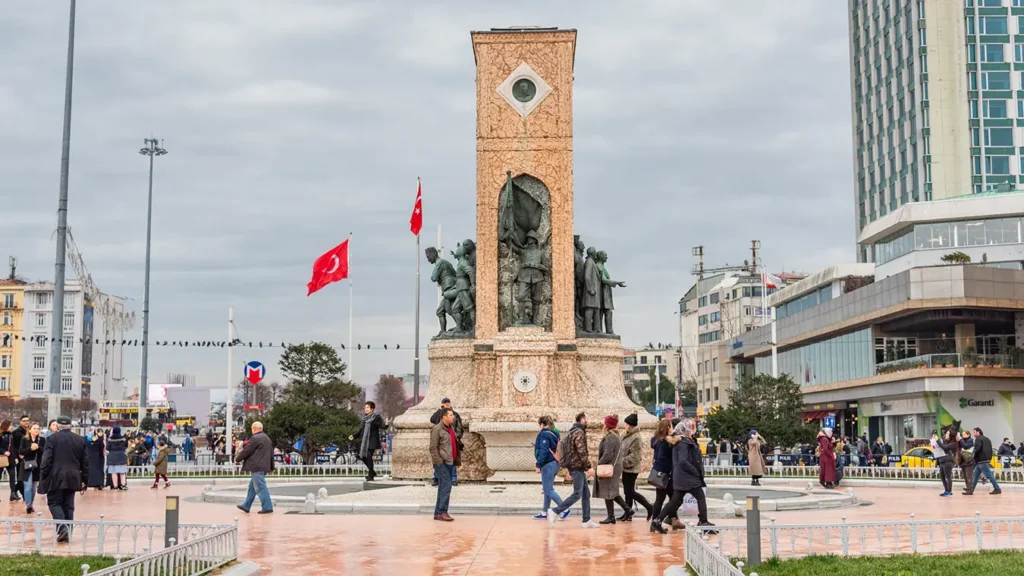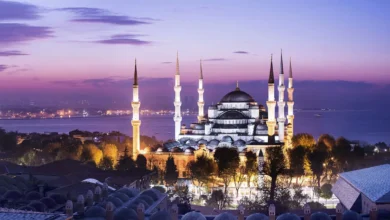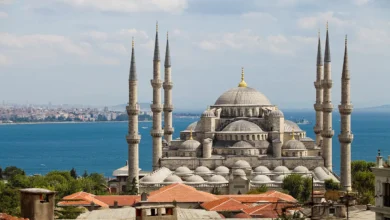
Taksim Square is the beating heart of Istanbul, radiating the city’s vibrant energy. Situated on the European side, this bustling public space is more than just a landmark; it’s a lively epicenter of culture, commerce, and social life. Serving as a key meeting point, it reflects the dynamic and ever-evolving spirit of Istanbul. Join us as we explore the rich history and cultural significance of this iconic square.
Taksim Square: The Heart of Istanbul
Istanbul stands as a bridge between Asia and Europe, and Taksim Square epitomizes this convergence. Situated in the city’s central district, Taksim beautifully fuses modern, Western, and cosmopolitan elements with the rich legacy of Istanbul’s medieval past. Influenced by Greek, European, Genoese, and Jewish cultures, Taksim’s unique character contrasts with the more traditional, Islamic look of the Old City. As one of Istanbul’s most iconic landmarks, Taksim Square traces its name to its origins as a historic water distribution point.
An Overview of Taksim Square
Taksim Square is a vibrant focal point, encircled by hotels, shops, restaurants, and cultural centers. Its expansive open space, lively streets, and buzzing atmosphere make it one of the city’s most dynamic areas.
Historical Significance
Taksim Square, once known as “Water Square” during the Ottoman era, has evolved significantly over time. It rose to prominence during the early years of the Turkish Republic and has since played a key role in major historical events and public demonstrations, cementing its place in the national consciousness.
Modern Importance
Today, Taksim Square is not only a central transportation hub but also a gathering place for both locals and tourists. It embodies the pulse of Istanbul, offering a starting point for those wishing to explore the city’s diverse neighborhoods and vibrant culture.

From Reservoir to Bustling Hub
The name “Taksim” itself reveals the square’s fascinating origins. Derived from the Arabic word for “division” or “distribution,” Taksim Square was historically a key water distribution point during the Ottoman period. Water from the northern aqueducts was collected and distributed from here, with a stone reservoir still standing today as a reminder of its essential role in the city’s infrastructure.
A Transformation Under the Republic
The founding of the Turkish Republic in 1923 marked a pivotal moment in Taksim Square’s history. The new government sought to transform the square into a symbol of modern Istanbul. In the 1930s, significant changes took place, with the construction of public buildings and the erection of the iconic Republic Monument. This monument, featuring Mustafa Kemal Atatürk, the republic’s founder, solidified Taksim Square’s role as a center for national celebrations and political demonstrations, becoming a powerful emblem of the nation’s progress.
A Gateway to Exploration
Today, Taksim Square is a vibrant crossroads, teeming with pedestrians who embrace its lively atmosphere. The nostalgic red tram, which travels along Istiklal Caddesi—the bustling pedestrian avenue leading from the square—adds a charming touch to the scene. Taksim Square serves as a perfect starting point for discovering the dynamic Beyoğlu district, renowned for its historic buildings, art galleries, lively bars, and acclaimed restaurants.
The square is home to several notable landmarks, including the Istiklal Anıtı (Independence Monument), honoring the founders of the Turkish Republic, as well as the Hagia Triada Greek Orthodox Church and the French Institute. From Taksim Square, visitors can explore Istiklal Caddesi, Istanbul’s famous commercial artery, lined with shops and cultural venues.
As you continue along the street, you’ll reach the Galata Tower, an ancient defense structure offering stunning panoramic views of the city. For those keen on seeing the views, the tower’s terrace is worth the wait in line. Alternatively, relax at a nearby café with a Turkish coffee or beer, taking in the grandeur of this iconic historical monument.

A Symbol of Change
Taksim Square’s history is marked by its role as a stage for protests and social movements, capturing the dynamic political landscape of Turkey. Its central location and symbolic significance have made it a powerful focal point for public gatherings and demonstrations, where key moments of change in the nation’s history have unfolded.
A Hub of Transportation and Commerce
Today, Taksim Square is a key transportation hub in Istanbul. It serves as the terminus for the nostalgic red tram that travels along Istiklal Caddesi, a lively pedestrian avenue leading to the historic Beyoğlu district. The square is also a central station for the Istanbul Metro, providing easy access to the city’s various neighborhoods.
In addition to its transportation role, Taksim Square is a thriving commercial center. Its perimeter is lined with restaurants, cafes, and shops that cater to both locals and tourists. Street vendors further enhance the square’s vibrant atmosphere, offering everything from traditional Turkish delights to souvenirs.
Taksim Square also serves as a popular gathering place for both residents and visitors. Surrounded by bars, nightclubs, businesses, and budget accommodations, it’s a central meeting spot and a favored hangout for travelers, particularly backpackers seeking a lively experience in the heart of Istanbul.
The Republic Monument: A Symbol of Independence at Taksim Square
One of Taksim Square’s most significant historical landmarks is the Republic Monument, which was constructed in 1928 by the Italian sculptor Pietro Canonica with public donations. Designed to honor Mustafa Kemal Atatürk, the founder of the Republic of Turkey, the monument stands as a tribute to his leadership and vision. In the statue, Atatürk is depicted in two key roles: as the commander-in-chief of the military and as a statesman.
Monument Details
On the southern side of the monument, facing Sıraselviler Street, Atatürk is portrayed alongside two other pivotal figures: İsmet İnönü and Marshal Fevzi Çakmak. These three individuals represent the founding pillars of the Turkish Republic, symbolizing the unity and collective effort that led to the country’s independence.
Behind İnönü and Çakmak are statues of two Russian generals: Mikhail Vasilyevich Frunze and Marshal Kliment Yefremovich Voroshilov. These figures symbolize the military support provided by Vladimir Lenin during the Turkish War of Independence and reflect the historical ties between Turkey and Russia.
Symbols and Other Views
On the northern side of the monument, a symbol of the Turkish War of Independence is featured, capturing the resolve and resistance of the Turkish people against foreign occupiers. Additionally, on the eastern and western sides, a soldier holding the Turkish flag is depicted, representing the pride and achievements of the Turkish army.
The Republic Monument is not only a remarkable work of art but also a symbol of Turkey’s history, culture, and its struggle for freedom and independence. It is a popular site for both locals and tourists and serves as a gathering point for national events and celebrations.
Events and Demonstrations

Gezi Park Protests
In 2013, Taksim Square became the epicenter of the Gezi Park protests, a pivotal series of demonstrations against controversial urban development plans. The protests, which quickly spread across the country, sparked widespread debate and played a key role in shaping Turkey’s social and political landscape, leaving a lasting impact on the nation’s public discourse.
Annual Celebrations
Taksim Square is a hub for numerous annual celebrations and events, including New Year’s Eve festivities, Independence Day parades, and cultural festivals. These occasions draw thousands of visitors from around the globe, making the square a vibrant focal point for both locals and tourists to come together and celebrate.

Attractions near Taksim Square
The Grand Pera Palace Hotel
Perched on a hilltop, the Grand Pera Palace Hotel is a stunning late 19th-century treasure, rich with history. Discover the opulent Art Deco interiors, visit Agatha Christie’s iconic room, or simply soak in the grandeur that once hosted royalty, dignitaries, and celebrities. A stay or a visit here offers a captivating window into Istanbul’s storied past.
Dolmabahçe Palace
Just a short distance from Taksim Square, Dolmabahçe Palace is a symbol of Ottoman grandeur. This 19th-century palace, once the empire’s administrative center, offers a glimpse into a lavish world. Explore its ornate rooms, wander through peaceful gardens, and immerse yourself in the palace’s majestic atmosphere.
Hagia Sophia Grand Mosque
A UNESCO World Heritage Site, the Hagia Sophia Grand Mosque is an architectural marvel with a layered history. Originally a church, later a mosque, and then a museum, it has returned to its mosque status. Inside, be awestruck by the vast dome, intricate mosaics, and the spiritual majesty of this iconic structure.
The Grand Bazaar
A visit to Istanbul wouldn’t be complete without exploring the Grand Bazaar, one of the world’s largest and oldest covered markets. Dating back to the 15th century, this vast marketplace is a shopper’s haven with over 4,000 shops offering everything from carpets and jewelry to spices, ceramics, and unique Turkish treasures. Test your bargaining skills while immersing yourself in the lively atmosphere of this historic site.
Istiklal Caddesi
This bustling pedestrian avenue is the heartbeat of Istanbul, brimming with life. Stroll through its eclectic mix of shops, cafes, restaurants, art galleries, and historical landmarks. Hop on the nostalgic red tram for a charming ride or simply soak in the vibrant atmosphere that makes Istiklal Caddesi one of the city’s most iconic streets.
Museum of Turkish and Islamic Arts
Step into the Museum of Turkish and Islamic Arts to discover Turkey’s rich cultural and artistic heritage. The museum features an impressive collection of carpets, ceramics, calligraphy, and other artifacts, offering an insightful journey through centuries of Islamic and Turkish artistic traditions.

Where is Taksim Square?
Taksim Square is one of Istanbul’s most iconic public spaces, located in the Beyoğlu district on the European side of the city. Situated at the eastern end of Istiklal Avenue, a famous shopping street, Taksim Square serves as a major cultural and social hub. Thanks to its central location and easy access to other popular attractions, it is a favorite destination for both tourists and locals.
Getting to Taksim Square
By Metro:
For those arriving in Istanbul, the metro is an ideal way to reach Taksim Square. Start by taking the red line “M1A” from the Atatürk Airport station. After 17 stops, you’ll reach the Yenikapı station, where you can transfer to the green “M2” line. After four more stops, you will arrive at Taksim station.
By Tram and Funicular:
If you’re traveling from the Sultanahmet area, the tram is a convenient option. From Sultanahmet, take the “T1” tram line. At the “Fındıklı Mimar Sinan Universitesi” station, get off and walk about one kilometer northwest to reach Taksim Square. Alternatively, you can switch to the funicular at the “Kabataş” station, which connects directly to Taksim Square. The funicular takes only two minutes, and it’s just a short 250-meter walk west to the square.
By Taxi:
For those looking for a more comfortable and direct option, taxis are readily available. The taxi stand is located just 130 meters north of the square. Taxis serving routes like Taksim-Aksaray and Şişli-Eminönü are frequently available, making this a quick and easy choice, especially for those in a hurry.
By Bus:
Tourists who prefer bus travel will find a bus station just north of Istiklal Avenue, about 150 meters from Taksim Square. The luxury “HAVAIST” buses also provide a convenient shuttle service between Istanbul Airport and Taksim, allowing passengers to travel directly from the airport to the square.
On Foot:
Taksim Square is also an excellent destination for walking. The square offers a spacious, traffic-free environment perfect for strolling and exploring the surrounding attractions. Visitors can easily walk to Istiklal Avenue, which is lined with shops, cafes, and restaurants. A walk around the square also offers a chance to experience the local culture and daily life of Istanbul’s residents.
Conclusion
Despite its occasional moments of turbulence, Taksim Square remains a powerful symbol of Istanbul’s spirit. It’s a place where tradition and modernity converge, where history whispers from its cobbled streets, and where the city’s vibrant energy pulsates. A visit to Taksim Square offers a glimpse into the heart of Istanbul, a city that is both ancient and modern, dynamic and captivating.
FAQs
1. Where is Taksim Square located?
Taksim Square is situated in the Beyoğlu district of Istanbul, on the European side of the city. It is a central location, easily accessible from various parts of Istanbul and close to other popular attractions like Istiklal Street.
2. How can I reach Taksim Square?
- By Metro: The M2 Metro Line has a direct stop at Taksim Square. If you’re coming from other parts of the city, you can transfer from the M1 or M4 lines.
- By Tram: The T1 Tram Line stops at Kabataş; from there, you can take the F1 funicular to reach Taksim.
- By Taxi: Taxis are readily available and provide a direct route to the square.
3. What is the main attraction at Taksim Square?
The Republic Monument is the main historical attraction in Taksim Square, commemorating the founding of the Turkish Republic in 1923. The monument features Mustafa Kemal Atatürk and other key figures.
4. What can I do near Taksim Square?
- Istiklal Street: A bustling pedestrian street full of shops, cafes, and historic buildings.
- Cultural Centers: Visit the Atatürk Cultural Center for performances, or explore nearby museums.
- Restaurants and Nightlife: Taksim is known for its vibrant dining and nightlife scene.
5. Are there any nearby hotels?
Yes, there are numerous hotels ranging from luxury to budget options around Taksim Square, catering to a variety of travelers.





